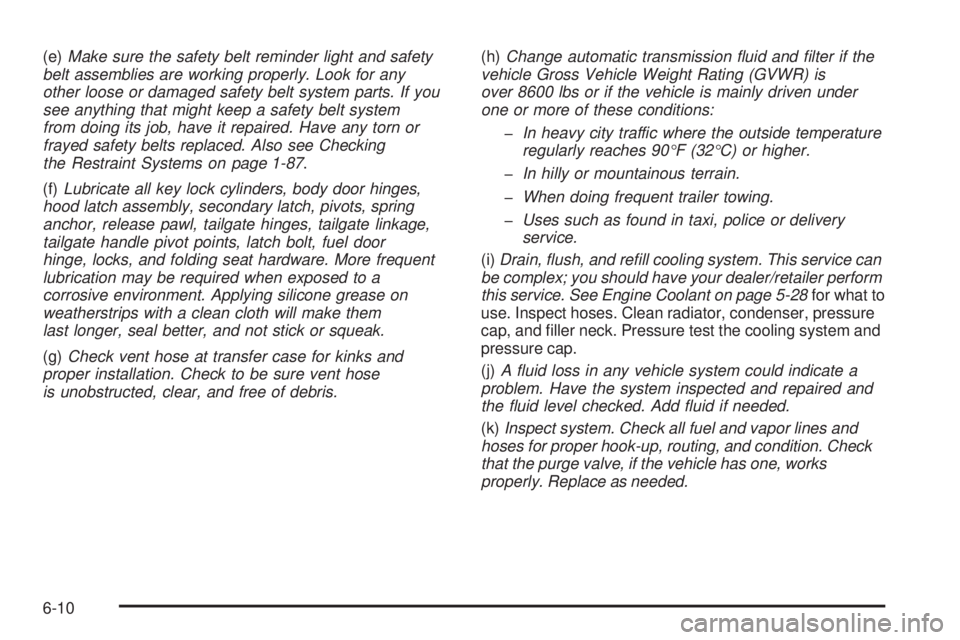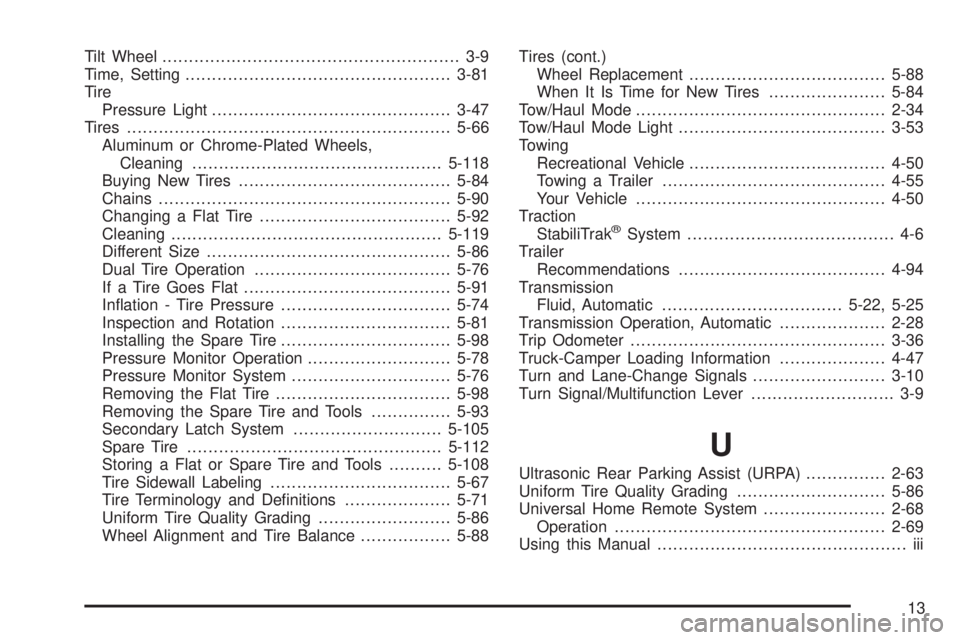2008 GMC SIERRA trailer
[x] Cancel search: trailerPage 425 of 578

If you no longer have the overheat warning, you can
drive. Just to be safe, drive slower for about 10 minutes.
If the warning does not come back on, you can drive
normally.
If the warning continues, pull over, stop, and park your
vehicle immediately.
If there is still no sign of steam and your vehicle has an
engine-driven cooling fan, push down the accelerator
until the engine speed is about twice as fast as normal
idle speed for at least �ve minutes while you
are parked.
If there is still no sign of steam and your vehicle has an
electric cooling fan, idle the engine for �ve minutes
while you are parked.
If you still have the warning, turn off the engine and get
everyone out of the vehicle until it cools down. Also,
see “Overheated Engine Protection Operating Mode”
later in this section.
You may decide not to lift the hood but to get service
help right away.Overheated Engine Protection
Operating Mode (V8 Engines Only)
If an overheated engine condition exists and the
REDUCED ENGINE POWER message is displayed, an
overheat protection mode which alternates �ring groups
of cylinders helps prevent engine damage. In this mode,
you will notice a loss in power and engine performance.
This operating mode allows your vehicle to be driven to a
safe place in an emergency. Driving extended miles (km)
and/or towing a trailer in the overheat protection mode
should be avoided.
Notice:After driving in the overheated engine
protection operating mode, to avoid engine damage,
allow the engine to cool before attempting any
repair. The engine oil will be severely degraded.
Repair the cause of coolant loss, change the oil
and reset the oil life system. SeeEngine Oil
(Gasoline Engine) on page 5-15.
5-33
Page 431 of 578

Engine Fan Noise
If your vehicle has a clutched engine cooling fan, when
the clutch is engaged, the fan spins faster to provide
more air to cool the engine. In most everyday driving
conditions, the fan is spinning slower and the clutch is
not fully engaged. This improves fuel economy and
reduces fan noise. Under heavy vehicle loading, trailer
towing, and/or high outside temperatures, the fan speed
increases as the clutch more fully engages, so you may
hear an increase in fan noise. This is normal and should
not be mistaken as the transmission slipping or making
extra shifts. It is merely the cooling system functioning
properly. The fan will slow down when additional cooling
is not required and the clutch disengages.
You may also hear this fan noise when you start the
engine. It will go away as the fan clutch partially
disengages.
If your vehicle has electric cooling fans, you may hear
the fans spinning at low speed during most everyday
driving. The fans may turn off if no cooling is required.
Under heavy vehicle loading, trailer towing, and/or high
outside temperatures, or if you are operating your air
conditioning system, the fans may change to high speed
and you may hear an increase in fan noise.
This is normal and indicates that the cooling system is
functioning properly. The fans will change to low speed
when additional cooling is no longer required.
Power Steering Fluid
SeeEngine Compartment
Overview on page 5-14for
reservoir location.
When to Check Power Steering Fluid
It is not necessary to regularly check power steering �uid
unless you suspect there is a leak in the system or you
hear an unusual noise. A �uid loss in this system could
indicate a problem. Have the system inspected and
repaired.
5-39
Page 519 of 578

Fuses Usage
1 Right Trailer Stop/Turn Lamp
2Electronic Suspension Control,
Automatic Level Control Exhaust
3 Left Trailer Stop/Turn Lamp
4 Engine Controls
5Engine Control Module, Throttle
Control
6 Trailer Brake Controller
Fuses Usage
7 Front Washer
8 Oxygen Sensor
9 Antilock Brakes System 2
10 Trailer Back-up Lamps
11 Driver Side Low-Beam Headlamp
12 Engine Control Module (Battery)
13Fuel Injectors, Ignition Coils
(Right Side)
14Transmission Control Module
(Battery)
15 Vehicle Back-up Lamps
16Passenger Side Low-Beam
Headlamp
17 Air Conditioning Compressor
18 Oxygen Sensors
19 Transmission Controls (Ignition)
20 Fuel Pump
21 Fuel System Control Module
22 Not Used
23 Not Used
24Fuel Injectors, Ignition Coils
(Left Side)
25 Trailer Park Lamps
26 Driver Side Park Lamps
5-127
Page 521 of 578

J-Case Fuses Usage
57 Cooling Fan 1
58 Not Used
59 Heavy Duty Antilock Brake System
60 Cooling Fan 2
61 Antilock Brake System 1
62 Starter
63 Stud 2 (Trailer Brakes)
64 Left Bussed Electrical Center 1
65 Not Used
66 Heated Windshield Washer System
67 Four-Wheel Drive System
68Stud 1
(Trailer Connector Battery Power)
(Optional - 40A Fuse Required)
69 Mid-Bussed Electrical Center 1
70 Climate Control Blower
72 Not Used
73 Left Bussed Electrical Center 2Relays Usage
FAN HI Cooling Fan High Speed
FAN LO Cooling Fan Low Speed
ENG EXH VLV Not Used
FAN CNTRL Cooling Fan Control
HDLP LO/HID Low-Beam Headlamp
FOG LAMP Front Fog Lamps
A/C CMPRSR Air Conditioning Compressor
STRTR Starter
PWR/TRN Powertrain
FUEL PMP Fuel Pump
PRK LAMP Parking Lamps
REAR DEFOG Rear Defogger
RUN/CRANK Switched Power
5-129
Page 534 of 578

(e)Make sure the safety belt reminder light and safety
belt assemblies are working properly. Look for any
other loose or damaged safety belt system parts. If you
see anything that might keep a safety belt system
from doing its job, have it repaired. Have any torn or
frayed safety belts replaced. Also see Checking
the Restraint Systems on page 1-87.
(f)Lubricate all key lock cylinders, body door hinges,
hood latch assembly, secondary latch, pivots, spring
anchor, release pawl, tailgate hinges, tailgate linkage,
tailgate handle pivot points, latch bolt, fuel door
hinge, locks, and folding seat hardware. More frequent
lubrication may be required when exposed to a
corrosive environment. Applying silicone grease on
weatherstrips with a clean cloth will make them
last longer, seal better, and not stick or squeak.
(g)Check vent hose at transfer case for kinks and
proper installation. Check to be sure vent hose
is unobstructed, clear, and free of debris.(h)Change automatic transmission fluid and filter if the
vehicle Gross Vehicle Weight Rating (GVWR) is
over 8600 lbs or if the vehicle is mainly driven under
one or more of these conditions:
�In heavy city traffic where the outside temperature
regularly reaches 90°F (32°C) or higher.
�In hilly or mountainous terrain.
�When doing frequent trailer towing.
�Uses such as found in taxi, police or delivery
service.
(i)Drain, flush, and refill cooling system. This service can
be complex; you should have your dealer/retailer perform
this service. See Engine Coolant on page 5-28for what to
use. Inspect hoses. Clean radiator, condenser, pressure
cap, and �ller neck. Pressure test the cooling system and
pressure cap.
(j)A fluid loss in any vehicle system could indicate a
problem. Have the system inspected and repaired and
the fluid level checked. Add fluid if needed.
(k)Inspect system. Check all fuel and vapor lines and
hoses for proper hook-up, routing, and condition. Check
that the purge valve, if the vehicle has one, works
properly. Replace as needed.
6-10
Page 535 of 578

(l)Extreme Duty Service: Change transfer case fluid if
the vehicle is mainly driven off-road in four-wheel
drive, or is used for heavy trailer towing. Farming,
mining, forestry, and Department of Natural Resources
(DNR) vehicles meet this definition.
(m)During any maintenance, if a power washer is used
to clean mud and dirt from the underbody, care should be
taken to not directly spray the transfer case output seals.
High pressure water can overcome the seals and
contaminate the transfer case fluid. Contaminated fluid
will decrease the life of the transfer case and should be
replaced.
(n)Vehicles with diesel engine or with GVWR above
10,000 lbs (4 536 kg) only: Inspect shields for damage or
looseness. Adjust or replace as required. This is a
Noise Emission Control Service. Applicable to vehicles
sold in the United States and recommended for
vehicles sold in Canada.
(p)If you drive regularly under dusty conditions, inspect
the filter or change indicator (if equipped) at each
engine oil change.
(q)Visually inspect belt for fraying, excessive cracks, or
obvious damage. Replace belt if necessary.Owner Checks and Services
These owner checks and services should be performed
at the intervals speci�ed to help ensure the safety,
dependability, and emission control performance of your
vehicle. Your dealer/retailer can assist you with these
checks and services.
Be sure any necessary repairs are completed at once.
Whenever any �uids or lubricants are added to your
vehicle, make sure they are the proper ones, as shown
inRecommended Fluids and Lubricants on page 6-15.
At the First 100, 1,000 and 6,000
Miles (160, 1 600 and 10 000 km)
For vehicles with dual wheels, check dual wheel
nut torque. For proper torque, seeCapacities and
Specifications on page 5-130.
At Each Fuel Fill
It is important to perform these underhood checks at
each fuel fill.
6-11
Page 573 of 578

Mirrors
Automatic Dimming Rearview with Compass
and Temperature Display...........................2-57
Automatic Dimming Rearview with OnStar
®,
Compass and Temperature Display.............2-55
Manual Rearview Mirror................................2-55
Outside Manual Mirrors................................2-58
Outside Power Foldaway Mirrors....................2-61
Outside Power Mirrors..................................2-59
Outside Trailer-Tow Mirrors...........................2-59
MP3 ..................................................3-102, 3-106
MyGMLink.com................................................ 7-4
N
Navigation System, Privacy..............................7-18
Navigation/Radio System, see Navigation
Manual.....................................................3-112
New Vehicle Break-In......................................2-22
Noise Control System, Tampering......................5-56
O
Odometer......................................................3-36
Odometer, Trip...............................................3-36
Off-Road Driving.............................................4-12Off-Road Recovery..........................................4-10
Oil
Engine.......................................................5-15
Pressure Gage............................................3-50
Pressure Light.............................................3-51
Oil, Engine Oil Life System..............................5-18
Older Children, Restraints................................1-35
Online Owner Center........................................ 7-4
OnStar, Privacy..............................................7-18
OnStar
®System, see OnStar®Manual...............2-65
Operation, Universal Home Remote System........2-69
Other Warning Devices...................................... 3-8
Outlet Adjustment............................................3-33
Outlets
Accessory Power.........................................3-23
Outside
Manual Mirrors............................................2-58
Power Foldaway Mirrors...............................2-61
Power Mirrors.............................................2-59
Trailer-Tow Mirrors.......................................2-59
Overheated Engine Protection
Operating Mode..........................................5-33
Owner Checks and Services.............................6-11
Owners, Canadian............................................... ii
9
Page 577 of 578

Tilt Wheel........................................................ 3-9
Time, Setting..................................................3-81
Tire
Pressure Light.............................................3-47
Tires.............................................................5-66
Aluminum or Chrome-Plated Wheels,
Cleaning...............................................5-118
Buying New Tires........................................5-84
Chains.......................................................5-90
Changing a Flat Tire....................................5-92
Cleaning...................................................5-119
Different Size..............................................5-86
Dual Tire Operation.....................................5-76
If a Tire Goes Flat.......................................5-91
In�ation - Tire Pressure................................5-74
Inspection and Rotation................................5-81
Installing the Spare Tire................................5-98
Pressure Monitor Operation...........................5-78
Pressure Monitor System..............................5-76
Removing the Flat Tire.................................5-98
Removing the Spare Tire and Tools...............5-93
Secondary Latch System............................5-105
Spare Tire................................................5-112
Storing a Flat or Spare Tire and Tools..........5-108
Tire Sidewall Labeling..................................5-67
Tire Terminology and De�nitions....................5-71
Uniform Tire Quality Grading.........................5-86
Wheel Alignment and Tire Balance.................5-88Tires (cont.)
Wheel Replacement.....................................5-88
When It Is Time for New Tires......................5-84
Tow/Haul Mode...............................................2-34
Tow/Haul Mode Light.......................................3-53
Towing
Recreational Vehicle.....................................4-50
Towing a Trailer..........................................4-55
Your Vehicle...............................................
4-50
Traction
StabiliTrak
®System....................................... 4-6
Trailer
Recommendations.......................................4-94
Transmission
Fluid, Automatic..................................5-22, 5-25
Transmission Operation, Automatic....................2-28
Trip Odometer................................................3-36
Truck-Camper Loading Information....................4-47
Turn and Lane-Change Signals.........................3-10
Turn Signal/Multifunction Lever........................... 3-9
U
Ultrasonic Rear Parking Assist (URPA)...............2-63
Uniform Tire Quality Grading............................5-86
Universal Home Remote System.......................2-68
Operation...................................................2-69
Using this Manual............................................... iii
13